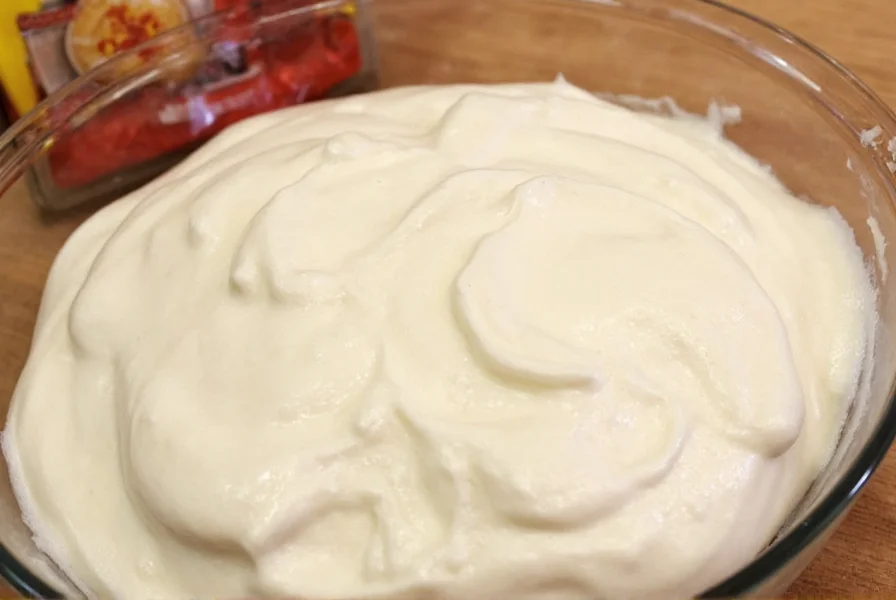Creating the perfect cream cheese frosting for cinnamon rolls requires understanding both ingredient science and technique. Many home bakers struggle with frosting that's either too thin to stay on warm rolls or too stiff to spread easily. The solution lies in precise measurements, proper ingredient temperatures, and strategic mixing techniques that maintain structural integrity while delivering that signature tangy-sweet flavor profile everyone loves.
Essential Ingredients for Perfect Cinnamon Roll Frosting
Understanding each component's role transforms your cream cheese frosting from ordinary to extraordinary. Professional bakers emphasize these critical elements when preparing homemade cream cheese frosting for cinnamon rolls:
| Ingredient | Function | Professional Tip |
|---|---|---|
| Cream cheese (full-fat) | Provides tangy flavor and structure | Must be at true room temperature (68-72°F) for smooth incorporation |
| Unsalted butter | Creates smooth texture and richness | Soften but not melt; should yield slightly when pressed |
| Powdered sugar | Sweetens and stabilizes | Sift before measuring to prevent lumps in easy cream cheese frosting for cinnamon rolls |
| Vanilla extract | Enhances overall flavor profile | Use pure extract, not imitation, for best results |
| Salt | Balances sweetness | ¼ teaspoon maximum to avoid overpowering the cream cheese |
Step-by-Step Cream Cheese Frosting Preparation
The technique matters as much as the ingredients when making best cream cheese frosting for cinnamon rolls. Follow these professional steps for flawless results:
- Temperature check: Ensure cream cheese and butter sit at room temperature for 2-3 hours. Cold ingredients cause lumpy frosting
- Initial creaming: Beat cream cheese alone for 1 minute until smooth before adding butter
- Gradual sugar addition: Incorporate powdered sugar in ½ cup increments, scraping bowl frequently
- Final texture adjustment: Add 1-2 teaspoons of milk only if necessary for spreading consistency
- Chill before use: Refrigerate for 15-20 minutes to firm up before applying to warm cinnamon rolls
Common Cream Cheese Frosting Problems and Solutions
Even experienced bakers encounter issues with cream cheese frosting for hot cinnamon rolls. Here's how to troubleshoot the most frequent challenges:
- Runny frosting: Caused by warm ingredients or excess liquid. Fix: Chill mixture for 15 minutes, then beat in additional ¼ cup powdered sugar
- Lumpy texture: Results from cold cream cheese. Fix: Return to mixer and beat on medium speed for 2-3 minutes
- Grainy consistency: Indicates undissolved sugar. Fix: Add 1 teaspoon of milk and beat on low speed for 1 minute
- Separation: Occurs when ingredients are too warm. Fix: Chill bowl and beaters, then re-whip mixture
Advanced Techniques for Perfect Cinnamon Roll Presentation
Professional pastry chefs use these methods when applying cream cheese frosting to warm cinnamon rolls:
- Temperature synchronization: Frost rolls when they're warm (not hot) - around 110°F internal temperature
- Layering technique: Apply thin crumb coat first, then chill for 5 minutes before final frosting layer
- Texture contrast: Sprinkle chopped pecans or cinnamon immediately after frosting for added dimension
- Flavor enhancement: Add ½ teaspoon of lemon zest to frosting for brighter flavor that cuts through richness
Storage and Serving Recommendations
Proper handling maintains the integrity of your homemade cinnamon roll cream cheese frosting:
- Room temperature: Frosted rolls stay fresh for 24 hours when covered with plastic wrap touching the frosting surface
- Refrigeration: Store up to 5 days; bring to room temperature 30 minutes before serving for optimal texture
- Freezing: Freeze unfrosted rolls, then add frosting after thawing and reheating for best results
- Reviving: Slightly dry frosting can be refreshed with a few drops of milk and gentle re-whipping
Creative Variations on Classic Cream Cheese Frosting
While traditional cream cheese frosting recipe for cinnamon rolls remains popular, these professional variations elevate your baking:
- Browned butter version: Replace half the butter with cooled browned butter for nutty complexity
- Citrus twist: Add 1 tablespoon of orange or lemon zest for bright flavor contrast
- Spiced frosting: Incorporate ½ teaspoon of cinnamon or pumpkin spice for seasonal appeal
- Maple cream cheese frosting: Substitute 2 tablespoons of pure maple syrup for some powdered sugar
Ingredient Substitutions and Dietary Adaptations
Professional bakers know how to modify cream cheese frosting for cinnamon rolls without dairy while maintaining quality:
- Dairy-free option: Use vegan cream cheese and butter substitutes, but add ½ teaspoon of apple cider vinegar for tang
- Lower sugar version: Replace ⅓ of powdered sugar with erythritol for reduced sweetness without texture compromise
- Gluten considerations: Ensure powdered sugar is certified gluten-free if serving gluten-sensitive guests
- Allergy-friendly: Coconut oil-based substitutes work but require chilling the frosting longer before application











 浙公网安备
33010002000092号
浙公网安备
33010002000092号 浙B2-20120091-4
浙B2-20120091-4